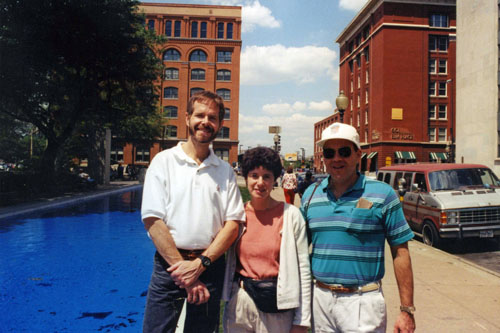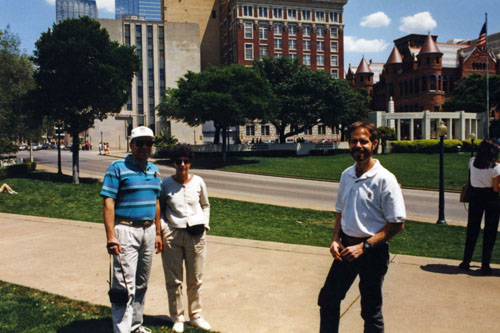


 |
July 3-5, 1998: July 4th at Possum Kingdom Lake |
 |
April 12, 1998: A Visit to the Dallas Arboretum |
 |
Return to the Index for 1998 |
I have been able to visit my good friend, Tony Hirsch, in Boston a number of times in conjunction with business travel there. We were an installation team in the 1970s when we both worked for Cullinane Corporation. Now, at long last, Tony is able to come down to Dallas for a visit- actually his second one since I moved here. This time, he was able to bring his wife, Roberta, with him.
Fred and I enjoyed getting the chance to show Tony and Roberta some of the sights of Dallas and Fort Worth.
Fort Worth's Sundance Square
|
This weekend, Sundance Square was having one of its frequent street fairs, and there would be kiosks run by artists and plenty of stuff to do. So we thought it would be a great way to spend one of our days.
Sundance Square is just one small part of the Sundance Square "district" in downtown Fort Worth. The name actually refers to an area of more than thirty square blocks of downtown, although the core of it is more like six or eight square blocks.
|
During the great cattle drives of the late 1800s, cowboys on the Chisholm Trail would visit downtown Fort Worth and patronize the many saloons, gambling parlors, shooting galleries, and dance halls that were located here. The Fort Worth Stockyards became the prime destination for these cattle drives, and there much of the beef consumed in the East and in Chicago (which also had its own stockyard operation) originated.
The district is named for the Sundance Kid who - along with his partner, Butch Cassidy - was a frequent visitor to the area. Wyatt Earp and Doc Holliday, well-known participants in the "Shootout at the OK Corral," could also be spotted from time to time.
|
With the demise of the stockyards (such operations having moved north into Oklahoma, Kansas and Nebraska), the city of Fort Worth lost some of its Western feel and luster. Other industries took up the slack, with a number of defense-related industries moving in. Even so, much of the new development in the city was, for many years, either suburban or concentrated around the Will Rogers Arena southwest of downtown; this is also where the museums and other attractions were.
The whole idea for a revitalization of the Sundance district came as part of an effort to bring downtown Fort Worth back to prominence as a destination for more than just office workers, and the effort has been very successful. Without a doubt, Sundance Square is a place where the past and future intersect, as now the renovated stockyards combine with restaurants, shops and performance venues (most notably Bass Hall) and night spots to offer visitors a wide variety of things to see and do.
|
The other picture, shows Tony, Roberta and I standing by the northwest corner of Ball Performance Hall. Somewhat smaller than the Myerson over in Dallas, it was donated to the city by the Bass family (who made their fortune in oil, of course).
We enjoyed the day immensely, and both Tony and Roberta found some items to buy at the art fair that was part of this weekend's activities.
Dealey Plaza in Dallas
|
The other thing for which Dallas is noted is, of course, as the location where President John F. Kennedy was shot and killed in 1963. This is something the city fathers would probably like to forget, but that's impossible. The building from which Lee Harvey Oswald was alleged to have fired the fatal shots is located at the western edge of downtown.
People are drawn to the site; on any given day you can see locals and tourists wandering around the "grassy knoll," trying to imagine a second assassin, or walking the motorcade route, which came south on Main past the old Dallas City Hall, turned north on Houston Street towards the Texas School Book Depository, and then made a left on Elm Street, intending to go underneath the KATY railway tracks and out to Stemmons Freeway for the trip to the Merchandise Mart.
Certainly everyone born before the late 1950s knows what happened (or what was alleged to have happened); most Boomers were probably glued to their televisions from the moment the major networks interrupted (actually, totally shelved) their schedules just after noontime that Friday and began their non-stop coverage that lasted well into the next week.
 In Dealey Plaza |
 On the "Grassy Knoll" |
So locals tend to bring visitors here- not that those visitors, like Tony and Roberta, didn't want to come anyway. My knowledge of the events of that day is not encyclopedic, but I have been to the Sixth Floor Museum (on the sixth floor of the Depository) enough times to be very familiar with what went on, and so I could point out to Tony and Roberta what happened, when and generally where. (In that last picture, that is Reunion Tower and the Hyatt Regency Hotel in the background- another iconic symbol that identifies Dallas.)
The Longhorns
So it is a bit unusual that one of the centerpieces of downtown Dallas is Pioneer Plaza and its longhorn sculptures.
|
The land on which the plaza sits, once railroad and warehouse property, was originally cleared for the failed Griffin Square development, which was to have featured a new hotel and a 55-story office tower. The cleared land sat unused for some time before real estate developer Trammell Crow got the idea for a public park. Hed had for some time wanted an iconic "Western" sculpture in the city of Dallas (not, apparently, listening to the citizens of Fort Worth) and assembled a group to donate the sculptures.
The $9 million project was begun in 1992 on the 4.2 acres donated by the City of Dallas; $4.8 million of the cost came from private funds raised from individuals and local businesses. Local artists sued to stop the project and claimed that it was historically inaccurate for the city, but the project was not derailed and the plaza opened in 1994.
Today the park is maintained by the adjacent Dallas Convention Center (formerly Reunion Arena) and is the second most visited tourist attraction in downtown Dallas. As a work in progress, an additional steer is occasionally added to the herd.
|
The 49 bronze steers and 3 trail riders sculptures were created by artist Robert Summers of Glen Rose, Texas. Each steer is larger-than-life at six feet high; all together the sculpture is the largest bronze monument of its kind in the world. Set along an artificial ridge and past a man-made limestone cliff, native landscaping with a flowing stream and waterfall help create the dramatic effect.
It is really a nice place to come visit, and you can click on the thumbnail images below to see some additional pictures of the longhorns, the trail riders and us:
 |
I think that Tony and Roberta were suitably impressed (although, perhaps, unaware of the historical "stretching of the truth" that the sculpture represents).
A Bike Ride at White Rock Lake
|
While it was a weekend, it was mid-afternoon when we got to the parking area at the northwest corner of the lake and got the bikes all unloaded and set up. Then we set off on the ride around the lake, returning 90 minutes later as the sun was setting.
I was riding the bike that Cullinane Corporation had given me twenty years earlier in recompense for my allowing Tony to use my Chicago apartment rather than a hotel on his frequent trips to the city. This was when I was off working for IST. Roberta rode Fred's bike and we rented two others for him and for Tony.
It was a really great afternoon and the weather was perfect.
We had a really nice visit from Tony and Roberta, and hoped that they would be able to come back again sometime.
You can use the links below to continue to another photo album page.
 |
July 3-5, 1998: July 4th at Possum Kingdom Lake |
 |
April 12, 1998: A Visit to the Dallas Arboretum |
 |
Return to the Index for 1998 |